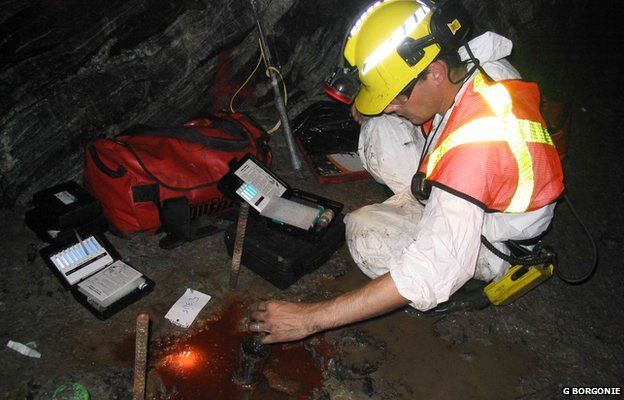Volume of world's oldest water estimated
- Published

The world's oldest water, which is locked deep within the Earth's crust, is present at a far greater volume than was thought, scientists report.
The liquid, some of which is billions of years old, is found many kilometres beneath the ground.
Researchers estimate there is about 11m cubic kilometres (2.5m cu miles) of it - more water than all the world's rivers, swamps and lakes put together.
The study was presented at the American Geophysical Union Fall Meeting.
It has also been published in the journal Nature.
The team found that the water was reacting with the rock to release hydrogen: a potential food source.
It means that great swathes of the deep crust could be harbouring life.
'Sleeping giant'
Prof Barbara Sherwood Lollar, from the University of Toronto, in Canada, said: "This is a vast quantity of rock that we've sometimes overlooked both in terms of its ability to tell us about past processes - the rocks are so ancient they contain records of fluid and the atmosphere from the earliest parts of Earth's history.
"But simultaneously, they also provide us with information about the chemistry that can support life.
"And that's why we refer to it as 'the sleeping giant' that has been rumbling away but hasn't really been characterised until this point."
The crust that forms the continents contains some of the oldest rocks on our planet.
But as scientists probe ever deeper - through boreholes and mines - they're discovering water that is almost as ancient.
The oldest water, discovered 2.4km down in a deep mine in Canada, has been dated to between one billion and 2.5bn years old.
Deep surprises
Prof Chris Ballentine, from the University of Oxford, UK, said: "The biggest surprise for me was how old this water is.
"That water is down there is no surprise - water will percolate down into the rock porosity.
"But for it to be preserved and kept there for so long is a surprise.
"So when you think about what's down beneath your feet, it's more exciting than just some rock."
As well as the new estimates for the volume of the ancient water, the researchers used data from 19 different mine sites, studied as part of the Deep Carbon Observatory programme, to assess how much hydrogen was being produced through the underground chemical reactions.
Life's limits
Prof Ballentine said: "Until our most recent work, the hydrogen production in the continental crust was calculated to be negligible: close to zero.
"This was very wrong and our work shows the hydrogen production in the continental crust to be the equal to that produced in the oceanic crust. This doubles the estimate of hydrogen produced on Earth."
Prof Sherwood Lollar said the hunt for life in the deep crust was now a priority.
"It gives us a quantum change in our understanding of how much of the Earth's crust might indeed be habitable and have enough energy to sustain subsurface life.
"We want to now follow this 'treasure map', to go to these sites to characterise just how broad this deep hydrosphere is, to characterise the extent of ages, and then to try to understand the differences in the kinds of life we might find in one fracture versus another.
"And even more exciting is if we can understand the limit to life, understand where we don't see life in the subsurface, and understand what it is about some of these fractures that makes them inhospitable for life."
Follow Rebecca on Twitter
- Published15 May 2013
- Published16 December 2014
- Published24 March 2011